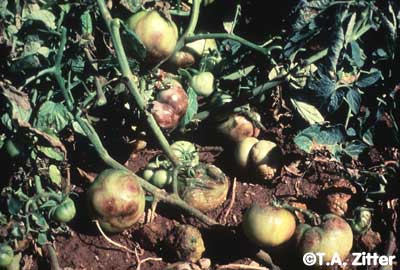 Wikipedia | Phytophthora infestans is an oomycete or water mold that causes the serious potato disease known as late blight or potato blight. (Early blight, caused by Alternaria solani, is also often called "potato blight"). It was a major culprit in the 1845 Irish and 1846 Highland potato famines. The organism can also infect tomatoes and some other members of the Solanaceae.
Wikipedia | Phytophthora infestans is an oomycete or water mold that causes the serious potato disease known as late blight or potato blight. (Early blight, caused by Alternaria solani, is also often called "potato blight"). It was a major culprit in the 1845 Irish and 1846 Highland potato famines. The organism can also infect tomatoes and some other members of the Solanaceae.epidemiology and disease development

Cornell | The following comments address pepper Phytophthora blight (P.capsici), and in general also apply for diseases of crops listed in the table. The fungus occurs naturally in most soils and can infect pepper and other crops at most stages of growth when there is excess soil moisture and warm, wet weather. The fungus overwinters in soil as thick-walled oospores. For pepper, the fungus also survives on and in infested seed, but this is not a factor with commercially purchased seed. Infected plants produce irregularly branched thread-like structures (sporangiophores) which in turn produce variously shaped sporangia spores. With adequate moisture the sporangia give rise to biflagellate (two-tailed) motile zoospores. These spores produce germ tubes that penetrate plant tissue. The cycle is repeated with the production of more sporangiophores and sporangia.
When the humidity is high, the sporangia can survive for long periods. During such times wind-borne sporangia can be carried long distances, causing widespread dissemination and a rapid increase in the disease. Zoospores are readily spread by splashing rain and by flowing irrigation and surface water. The disease develops first in low areas after heavy rains and can quickly spread throughout the field. Favorable conditions for the fungus include wet soils above 65°F (18°C) and prolonged wet periods with air temperatures in the 75-85°F (24-29°C) range (refer to fig.8).


0 comments:
Post a Comment